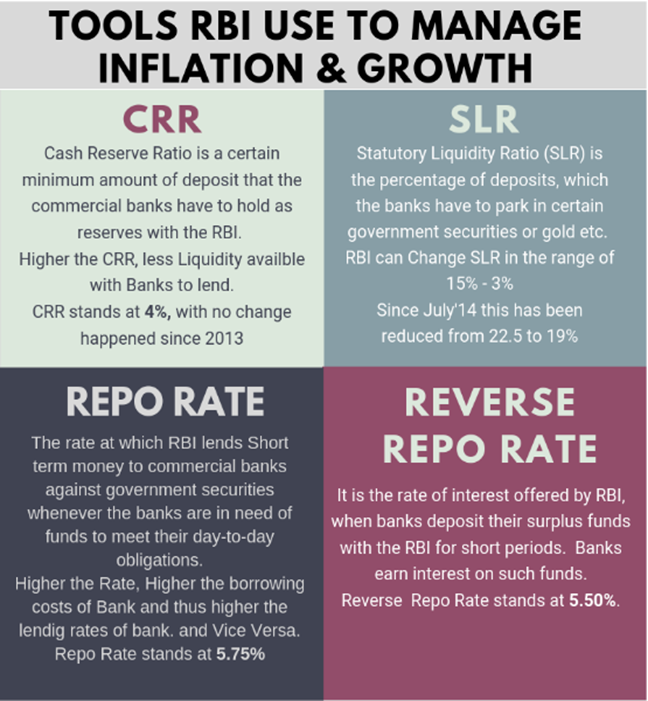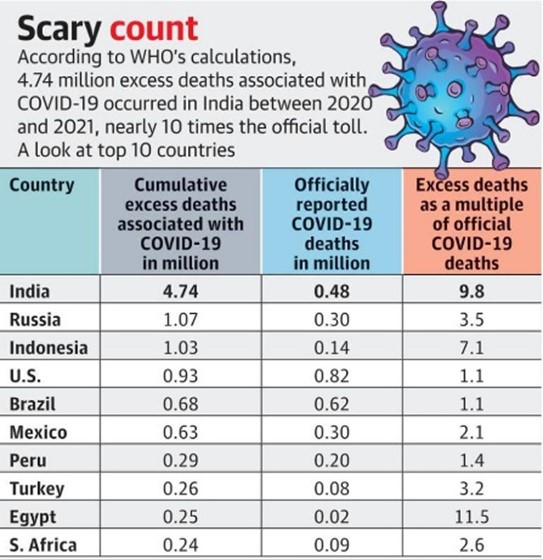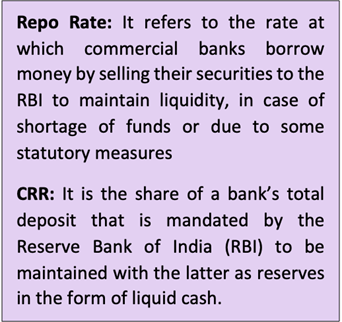Tuesday, 10th May 2022
Impending Wheat Crisis in India
In News
Wheat procurement by government agencies is set to dip to a 15-year low in the current marketing season, from an all-time high scaled last year.
About the News
- The government has lowered its wheat production estimates by 5.7% for the crop year ending June.
- Government procurement is likely to touch 19.5 MT when the season ends, which was 43.3 MT in the last marketing year.
- This year government had set a target of 44.4 MT of wheat procurement.
- Not all this, however, can be sold, as a minimum operational stock-cum-strategic reserve has to be maintained.
- Thus, after providing for the public distribution system, midday meals and other regular welfare schemes (total annual requirement of 26 MT), the quantity of wheat would be low in the government reserves.
Reasons for low procurement
- Unprecedented heatwaves across the north, west and central parts of the country, and March and April being the hottest in over 100 years, have caused substantial loss to the yield at 6%, with 20% of the wheat grain shrivelling up.
- Private traders have been prompted to buy more wheat from farmers as the price of wheat at the international level has shot up and is expected to rise due to the ongoing conflict between Russia and Ukraine.
- A large quantity of wheat was being bought by traders at a higher rate than the minimum support price (MSP).
- Also, farmers are holding on to some quantity of wheat, expecting higher prices for their produce in the near future.
Impact on the public distribution of grain
- The government has revised the grain allocation under Pradhan Mantri Garib Kalyan Anna Yojana (PMGKAY) for May to September 2022.
- According to the new guidelines, the FCI will fill the gap left by wheat with an increased allocation of rice.
- An additional 5.5 MT rice is being allocated to the States to fill the gap in supplying wheat grain.
- Under the National Food Security Act (NFSA), the annual requirement of rice is roughly about 35 MT.
- Government expects procurement of about 60 MT of rice this year.
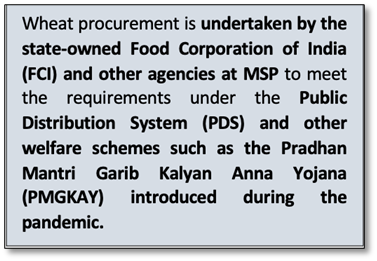
Other Impacts
- The price of wheat may increase due to low procurement. Private traders may start dictating the price in the domestic market.
- In such a case, the government may need to use the buffer stock under the Open Market Sale Scheme to control the market price.
- The government has dismissed concerns about both prices and stocks, asserting that India is in a comfortable situation with the overall availability of grains and stocks expected to be higher than the minimum requirement for the next one year.
- Farmers will benefit from the scenario as they are being offered a price above the MSP. Amid the Russia-Ukraine crisis, new markets in countries like Israel, Egypt, Tanzania and Mozambique have opened up for India.
- However, on the other hand, if private traders continue to buy above MSP, eventually that could stoke inflation.
- Despite the crop loss and revision of the output estimate, the Centre maintained that no curbs would be placed on wheat exports and that it was facilitating traders.
- After Egypt, Turkey has also given approval for the import of Indian wheat.
Sources:
No Aadhaar data for police investigations
In News
The Unique Identification Authority of India (UIDAI) has opposed a recent petition by Delhi Police to use the biometrics to help identify the accused in a case of murder.
About the News
- The Delhi police, had sought High Court’s directions to allow investigators to match a suspect’s picture and chance prints (latent fingerprints) from the crime scene with the Aadhaar database to help identify the accused in a case of murder.
- Under Section 33(1) of The Aadhaar Act, a judge of a High Court can order the disclosure of information on identity in certain cases.
- There is also a national security exception- an officer not below the rank of the Secretary to the central government can order disclosure of information including identity information or authentication record in the interest of national security.
- However, the UIDAI- a statutory body, which issues the unique Aadhaar number to residents of India, is prohibited by law from sharing any core biometric information with police.
- The Aadhaar (Targeted Delivery of Financial and Other Subsidies, Benefits and Services) Act, 2016 says that UIDAI “shall ensure confidentiality of identity information and authentication records of individuals”, and that no UIDAI employee can, either during service or later, “reveal any information stored in the Central Identities Data Repository or authentication record to anyone”.
- UIDAI has also said that it is not technologically feasible to accede to the request of the police.
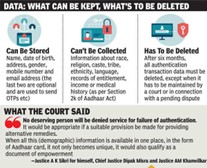
Data that the UIDAI collects
The authority collects demographic and biometric information of residents at the time of enrolment.
- Demographic information includes name, address, date of birth, gender, mobile phone number, and email address;
- Biometric information includes 10 fingerprints, two iris scans, and the resident’s photograph.
- The unique 12-digit Aadhaar issued after successful enrolment is a proof of identity to obtain a subsidy or service.

Tech impediment in Data Sharing
- The UIDAI has stated that, the Aadhaar technology only permits biometric authentications which are done on a 1:1 basis for which it is necessary to have the Aadhaar number of an individual.
- The technological architecture of UIDAI or its mandate for Aadhaar based authentication does not allow for any instance of 1:N matching wherein finger prints including latent and chance fingerprints are matched against the other finger prints in the UIDAI database, except for generation of Aadhaar number.
- UIDAI does not collect biometric information-iris scans and fingerprints-based on technologies, standards or procedures suitable for forensic purposes.
- Therefore using the biometric data for random matching purposes may not be technologically feasible and shall be beyond the purview of the Act.
- According to UIDAI, for Aadhaar based authentication, it was essential to have both “live biometrics” and the Aadhaar.
Source:
- Explained: Why, according to UIDAI, Aadhaar data can’t be used in police investigations
- Defined: Why, in keeping with UIDAI, Aadhaar information can’t be utilized in police investigations
Image source:
Inter-state arrests
In News
A Delhi resident was recently arrested by the Punjab police without informing the state police about it.
What are the various rules associated with inter-state arrests?
- Authority: Police is a state subject, and thus the jurisdiction of a state police is limited to the state. Broadly, the intent of the law has been that a criminal in a particular state must be arrested by the police of that state.
- Case of warrant: In certain circumstances the law does allow the police of one state to arrest an accused in another state. This may be done by the execution of a warrant issued by a competent court.
- Under the Section 48 of the Code of Criminal Procedure (CrPC) in cases where due to some reason warrant cannot procured on time, the state police can make arrest without a warrant by informing the local police about the arrest.
- Mandate: Under Article 22(2) of the Constitution, Police also have an obligation to present an arrested person before a magistrate within 24 hours.
- Court mandated guidelines: In 2019, in ‘Sandeep Kumar vs The State (Govt. Of NCT Of Delhi)’ case, the Delhi High Court issued certain guidelines for inter-state arrests.
- Permission: A police officer must seek permission from his superior, in writing or on the phone, to visit another state to arrest a criminal.
- On record: He/she must record reasons for a such a move in writing, and first make an endeavour to get an arrest warrant from a court except in “emergent cases”.
- Diary entry: The police team must also make “a comprehensive departure entry in the Daily Diary of his Police Station” before proceeding to another state.
- Intimidating local police: Before visiting the other State, the Police Officer must endeavour to establish contact with the local Police Station in whose jurisdiction he is to conduct the investigation and show translated copies of the Complaint/FIR and other documents in the language of the State which he intends to visit.
- Support and cooperation: The concerned SHO should provide/render all legal assistance to the visiting team and entry to this effect must be made at the said police station.
- Transmit remand: The guidelines also expect the police to make an effort to obtain transit remand after producing the arrested person before the nearest magistrate within 24 hours.
What are the major issues with this arrest?
Defaulting summons: In the present case, Punjab Police have maintained that the arrested person had been served five summons to join the investigations with regard to a case where he has been accused of making death threats to Delhi Chief Minister, but he failed to appear for questioning.
Breach of informal understanding: In many cases, accused are picked up in a state based on an informal understanding with the police of that state, and are then shown to have been arrested in the state to which the arresting police team belongs. This arrest is a classic example of the violation of jurisdiction and procedure based on an informal understanding between the police of Punjab and Delhi.
Sources:
Nelson Mandela as first black president of South Africa
On May 10, 1994, Nelson Mandela became South Africa’s first black president. His election ended more than three centuries of white rule in South Africa. His negotiations in the early 1990s with South African Pres. F.W. de Klerk helped end the country’s apartheid system of racial segregation and ushered in a peaceful transition to majority rule. Mandela and de Klerk were jointly awarded the Nobel Prize for Peace in 1993 for their efforts. He established in 1995 the Truth and Reconciliation Commission (TRC), which investigated human rights violations under apartheid, and he introduced housing, education, and economic development initiatives designed to improve the living standards of the country’s Black population.
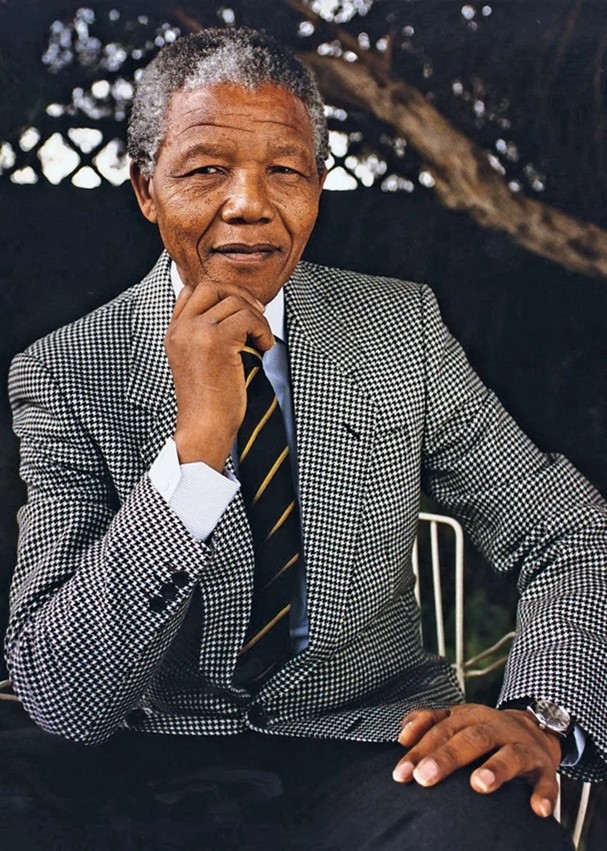
To know more on this day, refer:
Sources:
Carbon Pricing
In News
Pennsylvania State of US became the first fossil fuel producing state in the US to adopt a carbon pricing policy, as USA administration is attempting a less direct approach — known as the social cost of carbon, to bring down carbon emissions in the country.
About Carbon Pricing
- Carbon pricing is an instrument that captures the external costs of greenhouse gas (GHG) emissions—the costs of emissions that the public pays for, such as damage to crops, health care costs from heat waves and droughts, and loss of property from flooding and sea level rise—and ties them to their sources through a price, usually in the form of a price on the carbon dioxide (CO2) emitted.
- There is a growing consensus among both governments and businesses on the fundamental role of carbon pricing in the transition to a decarbonized economy.
- The success of carbon pricing at national and regional levels has encouraged development of international carbon markets.
- The Paris Agreement includes provisions that would allow countries to cooperate to achieve their NDCs, specifically through carbon pricing to meet mitigation commitments.
- Carbon prices now exist in 46 countries, covering about 22 percent of the carbon pollution that humans release each year.
Why is Carbon Pricing significant?
- According to the World Bank, using carbon pricing approaches on a large scale could reduce the cost of climate change mitigation by 32% by 2030.
- A price on carbon helps shift the burden for the damage from GHG emissions back to those who are responsible for it and who can avoid it.
- It provides an economic signal to emitters and allows them to decide to either transform their activities and lower their emissions or continue emitting and paying for their emissions.
- In this way, the overall environmental goal is achieved in the most flexible and least-cost way to society.
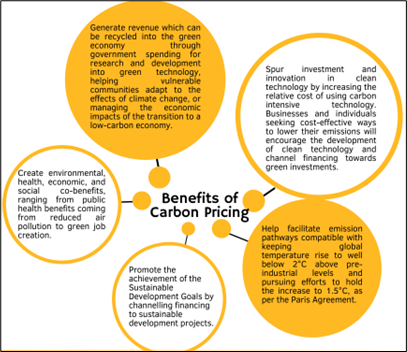
Instruments of carbon Pricing
Carbon pricing instruments can take many forms. A wide range of approaches and paths allows governments, businesses, and institutions to select the method best suited to the broader policy environment.

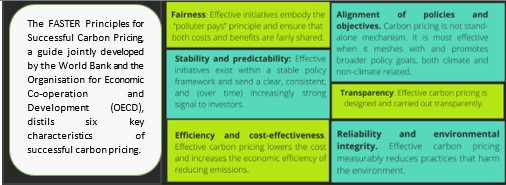
Challenges in Designing Effective Carbon Pricing
- Carbon leakage: When there is an inconsistent patchwork of carbon pricing policies and regulations at the regional and global levels, the result can be carbon leakage—that is, the phenomenon by which carbon-intensive industries or firms shift operations to lower-cost jurisdictions.
- Policy overlap or inconsistency: Carbon pricing instruments can be significantly be more effective if they are properly aligned with complementary policies, such as energy efficiency policies, emissions performance standards, and research and technology policies, among others.
- Ineffective use of revenues: The effectiveness of many carbon pricing initiatives depends on how these revenues are spent. Revenues can be recycled to reduce other conventional taxes, protect lower-income households, support cleaner technologies ans so on.
- Political Challenges: Governments grapple with lobbying by fossil fuel stakeholders, opposition from public, transparency concerns and institutional ineffectiveness during the implementation of carbon pricing policies.
- Calculating the carbon cost: According to World Bank, countries need policies that price carbon at $40 to $80 per tonne to meet the Paris Agreement targets.However, except for Sweden, Norway, Liechtenstein, Switzerland and France, no other country falls in the target range.
- Demand inelasticity: Even if the carbon producing activity is made costly, most of the times the emissions keep on increasing due to demand inelasticity. In Norway, which has one of the highest carbon prices in the world, emissions in the oil sector rose by 78 percent between 1990 and 2017.
India’s approach towards Carbon Pricing
India does not have an explicit carbon price or a market-based mechanism such as cap-and-trade. It does, however, have an array of schemes and mechanisms that put an implicit price on carbon.
- Perform, Achieve and Trade (PAT) Scheme: Under this scheme, energy intensive units from industrial sectors with high emissions are assigned specific energy reduction targets to be met by implementing energy-efficient technologies. Those unable to meet the targets may purchase ESCerts through a centralised online trading mechanism hosted by the Indian Energy Exchange (IEX).
- Coal Cess: In 2010, the government of India introduced a tax on coal, to be levied as excise duty on items listed in the tenth schedule to the Finance Act, 2010.
- Renewable Purchase Obligations (RPO) and Renewable Energy Certificates (REC): To provide a fillip to India’s growing renewable energy sector, all electricity distribution licensees are required to purchase or produce a minimum specified quantity of their requirements from renewable energy sources.
- Internal Carbon Pricing (ICP): Over the past few years, there has been remarkable support for carbon pricing by the private sector under ICP.
Conclusion: Carbon Pricing is a policy step necessary but not suffiecient to arrest the temperature rise. The need of the hour is to make the transition to green technology feasible for the industries alongwith the penalisation of carbon pricing. Moreover, balancing the cost of making carbon neutral choices should be made in such a way that the poor and vulnerable sections face minimal economic burden.
Question: What is Carbon Pricing and its various mechanisms? Discuss the steps taken by India in this direction
Sources:
- Explained: Can climate change be solved by pricing carbon?
- Carbon Pricing Dashboard
- Pricing Carbon
- WHAT IS CARBON PRICING?
- About Carbon Pricing
- What is carbon pricing?
- Why carbon pricing is not sufficient to mitigate climate change—and how “sustainability transition policy” can help
- Pricing carbon: The challenges
- The Promise and Problems of Pricing Carbon: Theory and Experience
- The Trouble with Carbon Pricing
- Pricing carbon: Trade-offs and opportunities for India
- The plethora of effective alternatives to carbon pricing
- Is India ready to have carbon tax?
Best Pic of UFO
This is image of a 50-Year-Old photo, which is being claimed that it shows an unidentified flying object (UFO). Published by a number of media outlets and shared widely on Twitter, the black and white photo shows a saucer-like object over Costa Rica. Users say that this is the best photograph of a UFO (believed to be used by aliens) ever taken. It was clicked by aerial photographer Sergio Loaiza in September, 1971, as he flew over Costa Rica on a mission to survey land for the construction of a hydroelectric project. The first well-known UFO sighting occurred in 1947, when businessman Kenneth Arnold claimed to see a group of nine high-speed objects near Mount Rainier in Washington while flying his small plane. Sightings of unidentified aerial phenomena increased, and in 1948 the U.S. Air Force began an investigation of these reports called Project Sign.
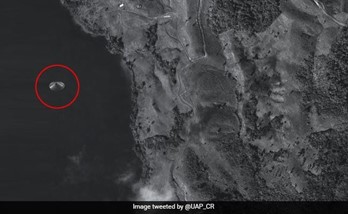
Sources:
Monkey Pox - Edukemy Current Affairs
- Context: Health authorities in the United Kingdom have recently confirmed a case of monkeypox, in an individual who had travelled from Nigeria.
- Monkeypox is a rare infection mainly spread by wild animals in parts of west or central Africa, and is caused by infection with Monkeypox virus.
- The infection was first discovered in 1958 following two outbreaks of a pox-like disease in colonies of monkeys kept for research, which led to the name ‘monkeypox’.
- However, the first human case was recorded in 1970 in the Democratic Republic of the Congo (DRC).
- It is a zoonotic disease that is transmitted from infected animals to humans.
- The related symptoms include fever, headache, muscle aches, back ache, exhaustion, swelling of lymph nodes etc.
- The incubation period (time from infection to symptoms) for monkeypox is usually 7-14 days but can range from 5-21 days.
- It is to be noted that, there is no safe, proven treatment for monkeypox yet.
- Thus, for the purpose of controlling infection smallpox vaccine, antivirals, and vaccinia immune globulin (VIG) are used.
- The largest incidence of the infection in the world is found in the Democratic Republic of Congo.

Source
- Explained: What is monkeypox, a smallpox-like disease from Africa that has been reported in the UK?
- Monkey Pox
Image source
Thalassemia
- Context: Experts have recently discovered blood stem cell transplant as a curative treatment for thalassemia.
- Thalassemia is an inherited (i.e., passed from parents to children through genes) blood disorder caused when the body doesn’t make enough of a protein called haemoglobin, an important part of red blood cells.
- It occurs when there’s an abnormality or mutation in one of the genes involved in haemoglobin production.
- The symptoms of thalassemia include: bone deformities, especially in the face, dark urine, delayed growth and development, excessive tiredness and fatigue, yellow or pale skin etc.
- The possible treatments include blood transfusions, bone marrow transplant and medications & supplements.
- Preventive measures include carrier screening, genetic counselling and prenatal diagnosis
- India is also known as the Thalassemia capital of the world.
- In 2020, the Central Government launched “Thalassemia Bal Sewa Yojna” for the underprivileged Thalassemic patients.
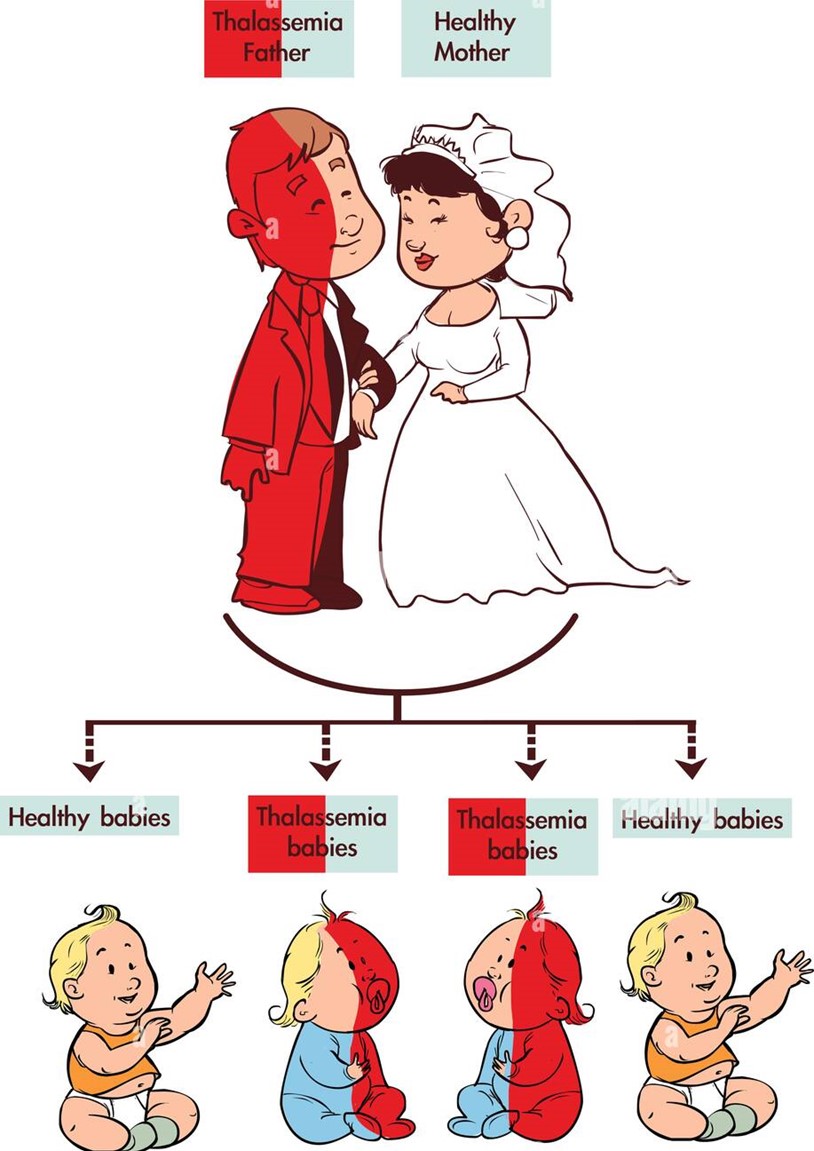
Source
- What is Thalassemia?
- Everything You Need to Know About Thalassemia
- Experts see blood stem cell transplant as a curative treatment for thalassemia
- Dr. Harsh Vardhan launches second phase of “Thalassemia Bal Sewa Yojna” for underprivileged Thalassemic patients
Image source
Martand Surya Temple
- Context: Lt Governor of Jammu and Kashmir has recently held prayers at Martand Surya Temple.
- The temple, located at Mattan in south Kashmir's Anantnag district, is the oldest Surya temple in the country.
- Martand is another Sanskrit synonym for Surya.
- According to Kalhana’s Rajatarangini, an account of the history of Kashmir between 1148 and 1149, the Martand Sun Temple was commissioned in the 8th Century AD by Lalitaditya Muktapida, a powerful ruler of Kashmir’s Karkota dynasty.
- It is seen as an excellent specimen of Kashmiri architecture- a blend of the Gandharan, Gupta and Chinese styles
- In accordance with Hindu temple architecture, the primary entrance to the temple is situated in the western side of the quadrangle and is the same width as the temple itself, creating grandeur.
- Various wall carvings in the antechamber of the temple depict Gods, such as Vishnu, and river goddesses, such as Ganga and Yamuna, in addition to the sun-god Surya.
- The temple is known to have destroyed by Sikandar Shah Miri (1389-1413)-who was the sixth sultan of the Shah Miri dynasty in an attempt to assert state power over Brahmins.
- The Temple has been listed as a “site of national importance” by the ASI.
- Rule 7(1) of the 1959 Ancient Monuments and Archaeological Sites and Remains, states that meetings, receptions, parties, entertainment or conferences cannot be held at a protected monument without permission in writing from the Central government.
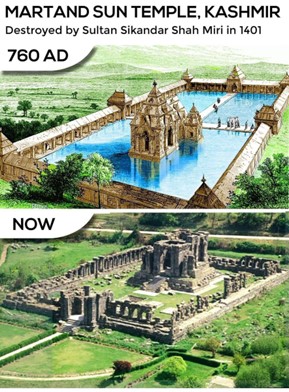
Source
- https://templesofindia.org/temple-view/martand-sun-temple-anantnag-jammu-and-kashmir-832mjb
- Devotees offer prayers at Martand Sun Temple temple ruins in the Kashmir Valley: What is its significance and why it is an architectural marvel
Image source
Thrissur Pooram
- Context: The most colourful temple festival Thrissur Pooram has begun in the Vadakkumnatha Temple in Thrissur, Kerala.
- Thrissur Pooram, held in the Malayalam month of Medam (April-May) at the Vadakkunnathan Temple annually, is one of the oldest temple festivals in Kerala.
- It is a resplendent festival celebrated with a grand display of caparisoned elephants, dazzling parasols, and percussion music.
- The major highlight of the festival is the musical ensemble which consists of traditional instruments like maddalam, edakka, thimila, chenda, and kombu.
- It is a magnificent spectacle merging the spiritual and cultural essence of Kerala.
- The festival was the brainchild of Sakthan Thampuran, the Maharaja of Cochin (1790–1805).
- Thrissur Pooram begins with the flag hoisting ceremony (Kodiyettam) which takes place seven days before the festival.
- Vadakkumnathan Temple is an ancient Hindu temple dedicated to Shiva at city of Thrissur, of Kerala.
- It is a classic example of the architectural style of Kerala and is believed to be the first temple built by Parasurama, the sixth avatar of Vishnu.
- It is famous for its Mural paintings depicting various scenes from the Mahabharata.

Source
- https://www.keralatourism.org/event/thirssur-pooram/7
- Thrissur Pooram: Interesting facts about Kerala's largest temple festival
- How to reach Vadakkunnathan Temple and be a part of the Thrissur Pooram festival?
Image source
IndiGo episode shows much needs to be done to ensure right to dignity in public spaces of persons with disabilities: Indian Express
Essence: A specially abled wheelchair bound teenager and his family were denied permission to board an Indigo airline in Ranchi's Birsa Munda airport. Airline denied permission because in its opinion the teenager was restless and might have created problems for passengers. This case has again raised issues related to ensuring dignity of people with disability.
The guidelines issued by the Director General of Civil Aviation in 2014 and Supreme Court judgment in Jeeja Ghosh vs Union of India clearly emphasizes the right of specially abled passengers to board aircraft and their life with dignity respectively. Article points out that to ensure an inclusive environment, these directives need to be implemented strictly.
Why should you read this article?
- To know about directives and Supreme Court judgements in favor of specially abled travelers.
Source:
Why the covid 19 numbers matter: The Hindu
Essence: The editorial makes the case for building a robust public health surveillance, reporting and prevention system through the example of excess deaths due to covid pandemic. The difference of nine times in covid death report by govt and WHO has been viewed with skepticism due to the alarming difference in numbers. The difference and difference seem to be staggering and irreconcilable. Keeping the mismanagement of covid in scenario, sudden lockdown, shortage of oxygen and hospital beds, vaccination issues, etc., excess deaths are an addition to it.
Internal reporting is designed to under-report. This is how reporting of death happens if one dies of diseases like malaria, typhoid, cholera, rabies, snake bite, etc. with tuberculosis being an exception (due to heavy death toll and elaborate surveillance under TB division).
Need is to have a public health division and infrastructure to collect and analyze data on diseases, with doctors reporting infectious diseases and signaling to control a possible outbreak. The numbers of dead shouldn’t be treated as ex post facto data but should serve as a cue for preventing infections, handling malnutrition with the help of statistics.
Why should you read this article?
- To know the advantages of creating a public health system for the nation.
- To understand the issues related with traditional system of death reporting.
Source:
Ukraine conflict won’t make Biden abandon Indo-Pacific strategy: Indian Express
Essence: The editorial talks of the ways USA is trying to handle the two front hostilities- one with Russia and another with China. The crisis in Europe speaks volumes about how a declining power could be disruptive in nature (read Russia). China, as well, faces multiple issues like strict covid lockdowns, declining economy, crack down on internet companies, hostile foreign/trade policies.
USA depends on a host of measures, the most important one being a latticework of alliances and partnerships. Renewing partnerships with ASEAN, South Korea and Japan and giving slack to India over trade with Russia are examples. Reinvigoration of Quad, stronger NATO ties and formation of AUKUS are similar examples. USA no more considers such relations as political and fiscal burden.
Unlike commonly understood that China had to gain from the Ukraine war, it is USA which profited from the crisis.
Why should you read this article?
- To know about the latest trends in international diplomacy in East Asia.
- To know the strength of alliance and partnership in present day war crisis.
Source:
Kisan Chachi
Background
- Rajkumari Devi of Anandpur, Muzzafarpur district, Bihar achieved unimaginable success through her learnings and spreading the same to others.
- Kisan Chachi, a social worker, was awarded the Padma Shri for her work in health and education, child marriage abolition, and widow rights and
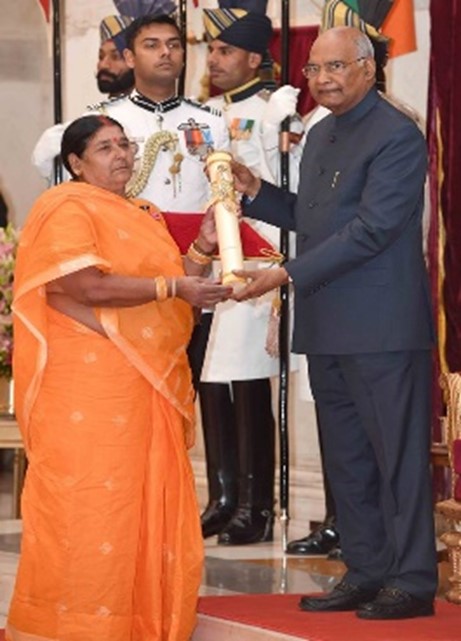
About Kisan Chachi
- Rajkumari Devi wished to impart farming skills to women labourers.
- Initially, she assisted her spouse in tobacco farming and tried to cultivate farming skills. Later, she separated her plots into parts and began cultivating a variety of fruits and vegetables, which proved profitable.
- She learned contemporary farming practises from Rajendra Agricultural University.
- Rajkumari experimented with pickle and murabba production after mastering agriculture. The company began with a minimal investment of 150. She used to cycle to other villages to sell her products.
- She has organised over 300 women into tiny self-help groups. She has established a Non-Profit Organization that not only collects fresh produce from farms run by women from various self-help groups, but also employs women to develop agro-based products.
- In 2007, she got awarded the “Kisan Shri” award by the Chief Minister of Bihar, Nitish Kumar. She was invited by Amitabh Bachchan on “Kaun Banega Crorepati’’ also.
- She gained recognition from the then Chief Minister of Gujarat, Narendra Modi. He uploaded the design of her food processing model on the official website and invited her to the vibrant Gujarat-2013 summit.
Quote: “Women will get empowered only when they themselves break the age-old chains of biased traditions and build a path for themselves.’’-Rajkumari Devi.
Source:
Share the article
Get Latest Updates on Offers, Event dates, and free Mentorship sessions.

Get in touch with our Expert Academic Counsellors 👋
FAQs
UPSC Daily Current Affairs focuses on learning current events on a daily basis. An aspirant needs to study regular and updated information about current events, news, and relevant topics that are important for UPSC aspirants. It covers national and international affairs, government policies, socio-economic issues, science and technology advancements, and more.
UPSC Daily Current Affairs provides aspirants with a concise and comprehensive overview of the latest happenings and developments across various fields. It helps aspirants stay updated with current affairs and provides them with valuable insights and analysis, which are essential for answering questions in the UPSC examinations. It enhances their knowledge, analytical skills, and ability to connect current affairs with the UPSC syllabus.
UPSC Daily Current Affairs covers a wide range of topics, including politics, economics, science and technology, environment, social issues, governance, international relations, and more. It offers news summaries, in-depth analyses, editorials, opinion pieces, and relevant study materials. It also provides practice questions and quizzes to help aspirants test their understanding of current affairs.
Edukemy's UPSC Daily Current Affairs can be accessed through:
- UPSC Daily Current Affairs can be accessed through Current Affairs tab at the top of the Main Page of Edukemy.
- Edukemy Mobile app: The Daily Current Affairs can also be access through Edukemy Mobile App.
- Social media: Follow Edukemy’s official social media accounts or pages that provide UPSC Daily Current Affairs updates, including Facebook, Twitter, or Telegram channels.

